In a few hours I’ll be on a plane to the other side of the world with just a suitcase and a small carry on. Over the last few weeks, I’ve been working out how to fit my life into such a small space. Normally, a backpack or small suitcase would be enough for me for to go for a few weeks, but this time I will be away for much longer than that.
Moving to a different country for as long as a year calls for dramatic changes. I’ve thought about it carefully and have decided that I will do it with less than 100 possessions. Getting down to 100 things has always been the kind of holy grail of minimalism, even though I know it isn’t for everyone. But as I had predicted in ‘Can Minimalism is Measured‘ (previous link) my needs have now changed and I am ready to take on the challenge.
getting down to less than 100
Before we start, I just want to clarify that I’ve grouped a couple of similar items with each other to make it easier, for example: socks, underwear, important documents, essential textbooks, purse, very small jewellery, makeup, electronic devices with their chargers and toiletries. Even though some people may count this stuff separately, to me, they come as a set, so I prefer to count them together. I think separating them would be bordering on a bit too extreme.
So here is my list of less than 100 things:
- important documents (passport, birth certificate etc.)
- laptop + case, charger etc.
- portable hard drive
- iphone + charger
- headphones
- camera
- nintendo ds
- socks
- underwear
- checked shirt
- checked shirt
- checked shirt
- checked shirt (I really like checked shirts)
- toiletries
- running shoes
- running shorts
- running trackies
- sports iphone strap
- running t-shirt
- brown t-shirt
- casual shoes
- black pumps
- black heels
- brown boots
- travel adaptor
- karate gi + belt
- leggings
- blue jeans
- denim shorts
- black shorts
- cream t-shirt
- ribbed vest
- dark grey top
- long grey top
- pink bow top
- pink and black top
- pink print top
- white and black top
- cream half top
- little black dress
- black pencil skirt
- black linen trousers
- beige coat
- beanie hat
- PJ’s
- PJ’s
- guitar accessories
- essential textbooks
- very small jewellery (only 5pcs)
- college shoulder bag
- rucksack
- blue handbag
- carry-on bag
- small purple bag
- small brown bag
- brown belt
- brown cardi
- light grey cardi
- face towel
- body towel
- straighteners
- makeup
- suitcase
So, that’s it. A total of 63 things that I’m taking with me to Japan. Even if I didn’t group a few of the things together, I think I would probably still make it under 100. Also, I haven’t counted the presents I’ve bought for my host family since they aren’t actually mine. (But because of them, I had to get a bigger suitcase!).
I also should add that I have a few items that I’ve left a home, they are things I still need but aren’t essential enough for me to take to me abroad:
- about 10-15 pieces of various clothing and accessories
- a few books
- my art posters
- bed sheets etc.
packing
Here is almost everything I own all laid out, looking quite messy and unpackable. I’ve tried to put everything here but I haven’t included a few things in this photo… namely my underwear 😉
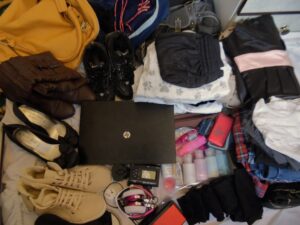
Read more about my minimalist wardobe and how to create one.
how to pack a minimalist suitcase
1. Reduce. The first thing you must absolutely do is reduce reduce reduce. Even if you have quite a small wardrobe already, chances are you may still have one or two things you haven’t worn very much that you can get rid of. It might help you to make a ‘definitely taking’ pile and a ‘maybe pile’. Then, look at the ‘maybe’ pile and ask yourself:
- does it fit me the way I want it to?
- is it easy to clean/does it require ironing/other maintenance?
- is it only suitable for certain occasions, or more than one?
- will I be able to wear this in different weather conditions?
- does it go with many other clothes?
- have I worn any of these in the past 4-6 months?
Obviously these are questions for clothes, but you can also pare down things like toiletries, gadgets etc. by asking yourself:
- how often do I use this?
- how easily can I buy a replacement?
- what is available to buy at my destination?
- what is the worse that can happen if I don’t bring it?
Systematically looking at each item and going through a few points in your head sounds like it will take a long time, but in my experience it actually only takes a few seconds for me to decide whether or not something is worth taking.
2. Sort. Decide what you will put in your suitcase and what you will take as carry-on. It might also help to decide what you will wear for the flight – if you choose the bulkiest/heaviest stuff, then you can fit a little more into the suitcase.
3. Compact. Once you’ve decided on what you’ll take, it’s time to start packing. In the above photo, I’ve folded and piled the clothes on top of each other. However, this kind of arrangement is only good for your everyday wardobe at home because you can then pull out any garment you want from the pile. In a suitcase however, you don’t need to do this and there are other more space-saving ways to pack clothes.
You could roll your clothes into tight cylinders, but I found another method via OneBag.com whereby you lay out all of your clothes flat in alternating directions and fold them around a ‘core’ which I chose to make out of clothes that were too short to make the outer layers.
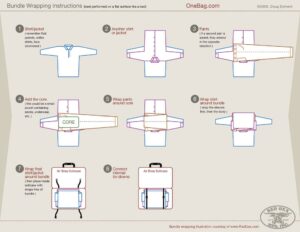
I managed to reduce this pile which measured about 32 cm in height:

To this pile which has all the same clothes, just folded differently. It measures just 20 cm in height, saving almost a third of the space. The bundles are also much easier to handle.
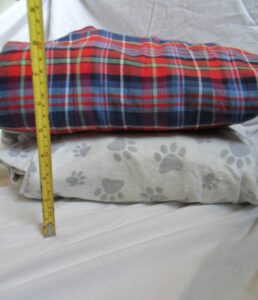
4. Arrange suitcase. After bundling the clothes, you want to pack everything into the suitcase. I’m taking a new 67cm trolley case I bought especially for this year. It is quite a huge suitcase, but I bought it because I didn’t want to squash the presents.
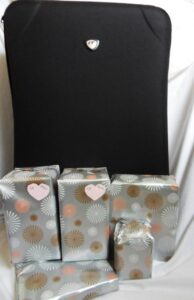
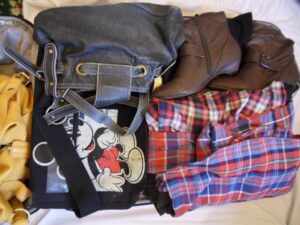
After a bit of Tetris manoeuvring, I managed to fit everything comfortably into the case. Two quick tips that helped me to pack things a little tighter were to use the insides of shoes and space around heels to pack socks and underwear and to wear your heaviest/bulkiest stuff on the plane instead of packing them.
5. Zip up and go. Finally, there’s not much left to do but wait! My flight will be at 07:30 am from London Heathrow. I’ll be making a stop in Rome before arriving at Kansai International at 09:55 the next day.
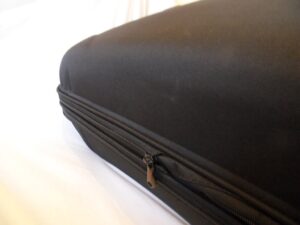
Wish me luck, I’ll see you on the other side 🙂



